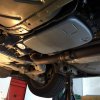Here's some more pics.
Freshening up the fluids, The 5L40 auto trans was 2.5qt's low. It's a sealed unit with no dip stick. Dropped the pan and replace the filter. The fluid was not in bad shape. I got 4.5 qts out and put in 6.5. I suspect it was flushed not long ago and didn't get the right amount of fluid back in. Since there is no dipstick, you fill it through a fill plug on the side. Start the car and get it hot and continue filling till it starts to come out of the fill hole. Notice the repurposed bug sprayer setup for oil dispenser. Put 3-4 qt's of trany fluid in it, pumped it up and open the ball valve to fill the trany. Verry easy and no-mess.
The 5L40 is used in a ton of GM cars as well as BMW.
Here's a few videos of the fluid change process.

Replace the battery, Interesting battery location. Kinda like the C4 Corvette except on the other side.


Underside

Posi differential...


Engine shots...



Here's some notes on the engine design out of an ECOTEC racing build book. In stock form, it appears to be a solid base for performance add on's and tunes. Very strong rotating assembly from the factory.
girdle or crankshaft are required.
Since 1955, the Small Block Chevy has proven its versatility, durability, and performance potential with automotive performance enthusiasts. The ECOTEC
engine has all the basic mechanical components to repeat this success. A sound base engine structure, excellent airflow capability, easy serviceability, compact size and low weight. These qualities, along with the very successful race program, demonstrate the ECOTEC engine is a
driving force in the sport compact segment.
GM’s ECOTEC engine has proven to be a reliable and competitive engine for use in Sport Compact Drag Racing. It has also proven it’s superior durability in grueling five mile runs at the Bonneville Salt Flats with speeds over 300
MPH and in showroom stock endurance road racing competition. The number of stock components utilized in
the race engine demonstrates the robust design of the ECOTEC engine. The ECOTEC’s outstanding feature to performance
enthusiasts is it’s impressive strength. GM Racing dynamometer tests confirm that major horsepower gains are possible with minimal modifications. For instance, when building an ECOTEC engine to the
400 hp power level, no modifications to the cylinder head, block, main
girdle or crankshaft are required. The production ECOTEC engine block is manufactured
out of aluminum using a lost-foam casting process. This process allows for both a stronger and lighter part.
Flanged, thin-wall iron cylinder sleeves are press-fit into a semi-floating aluminum support structure.
The ECOTEC
block is supported by a massive die-cast aluminum girdle/ main cap assembly and structural oil pan for noise and
vibration suppression. The main-cap structures are each supported with six fasteners. Extra-thick main bearings
resist the differential thermal expansion of the nodular iron crank and aluminum block.
All ECOTEC blocks are cast with passages for piston-cooling jets and an oil cooler for high-output
turbocharged applications. The fully-boxed block requires no windage tray, even on applications up to 600
horsepower. An auxiliary chain drives the water pump and balance shafts from the crank.
To reduce the risk of hot spots, pressure-cast, non-squish dished pistons are manufactured without valve reliefs. The
symmetrical, barrel-faced moly-coated top ring fits in an anodized ring-groove below a super-thin 3 mm top ring
land, creating a low crevice volume for reduced emissions. The pistons deliver power through full-floating piston pins
and powder-metal or forged steel connecting rods. The ECOTEC twin-cam cylinder head uses low-friction
hydraulic roller finger-followers, which have been proven reliable and effective up to 11,000 rpm. Head fastener
placement permits cylinder head removal and installation without removing the camshafts. The camshafts are driven
directly off the crank by a chain. The design includes provisions for variable cam phasing now found on select
ECOTEC variants. The finger-follower design permits a light-weight narrow profile and reduced valve angles(the
intake valve is 18 degrees from vertical and the exhaust valve 16 degrees).
The design of the intake manifold eliminates the need for variable-length intake runners and some ECOTEC
engines now include direct injection. The ECOTEC engine management system uses a port-EFI design with cassette waste-spark ignition.

![FullSizeRender[1].JPG FullSizeRender[1].JPG](https://garage.grumpysperformance.com/data/attachments/6/6394-82f5058a9fe00d5c050a55e24af870b5.jpg)
![FullSizeRender[2].JPG FullSizeRender[2].JPG](https://garage.grumpysperformance.com/data/attachments/6/6395-e019f7be6c0d348f4bcb4207bbee6e38.jpg)
![FullSizeRender[3].JPG FullSizeRender[3].JPG](https://garage.grumpysperformance.com/data/attachments/6/6396-206e1ef59e8ae5b5f635cbf7a7171c9a.jpg)
![FullSizeRender[4].JPG FullSizeRender[4].JPG](https://garage.grumpysperformance.com/data/attachments/6/6397-3aa258b455afe650bed4cccaf8b60b63.jpg)
![FullSizeRender[5].JPG FullSizeRender[5].JPG](https://garage.grumpysperformance.com/data/attachments/6/6398-0c024dc891210858ff31c1b6dda4922f.jpg)


![FullSizeRender[1].JPG FullSizeRender[1].JPG](https://garage.grumpysperformance.com/data/attachments/6/6394-82f5058a9fe00d5c050a55e24af870b5.jpg)
![FullSizeRender[2].JPG FullSizeRender[2].JPG](https://garage.grumpysperformance.com/data/attachments/6/6395-e019f7be6c0d348f4bcb4207bbee6e38.jpg)
![FullSizeRender[3].JPG FullSizeRender[3].JPG](https://garage.grumpysperformance.com/data/attachments/6/6396-206e1ef59e8ae5b5f635cbf7a7171c9a.jpg)
![FullSizeRender[4].JPG FullSizeRender[4].JPG](https://garage.grumpysperformance.com/data/attachments/6/6397-3aa258b455afe650bed4cccaf8b60b63.jpg)
![FullSizeRender[5].JPG FullSizeRender[5].JPG](https://garage.grumpysperformance.com/data/attachments/6/6398-0c024dc891210858ff31c1b6dda4922f.jpg)









